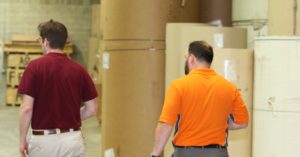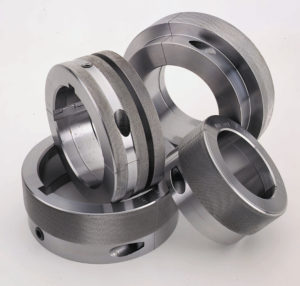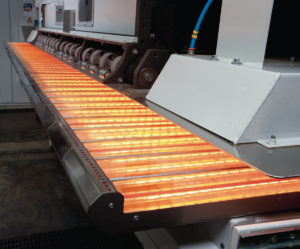 El tercer post de nuestro Los transformadores de cartón ondulado, en la encrucijada analizará cómo han evolucionado algunos equipos y soportes de impresión para ayudar a los impresores a mantenerse al día.
El tercer post de nuestro Los transformadores de cartón ondulado, en la encrucijada analizará cómo han evolucionado algunos equipos y soportes de impresión para ayudar a los impresores a mantenerse al día.
Equipos anticuados
Muchas de las prensas de postimpresión de cartón ondulado que funcionan hoy en día se instalaron hace medio siglo. ¿Cómo es posible que los fabricantes de cajas, con estos equipos, mantengan el ritmo de la calidad gráfica y los plazos de entrega que se esperan hoy en día?

The answer is, they can’t. At least not without incorporating the latest machine technology in their pressroom. Advancements in the powertrain, sheet transfer systems, substrates, coating chemistries and drying methods have made a huge impact on the speed and efficiency of the printing process and the quality of the output.
Servomotores de accionamiento directo
Conventional presses use mechanical gear systems to drive the anilox roll and plate cylinder in the ink delivery process. But as press speeds and the demand for higher quality print grows, these systems can’t hold sufficient registration and adjust for in-run variation. Wearing of the mechanical gears produce backlash in the system and cause deviations in the print registration. For this reason, corrugated OEMs have followed the lead of other flexo press manufacturers by substituting direct drive servo motors for gearing systems. These new direct drive configurations synchronize the transfer rolls with a much higher level of precision, removing the variability in the process, allowing for more repeatable registration and better control over in-run adjustments.
Transferencia por vacío
Del mismo modo, la nueva tecnología de transferencia por vacío elimina la variación de registro del proceso de transferencia de hojas. Los sistemas originales utilizan un rodillo de tracción moleteado para agarrar y tirar de  la hoja a través de la zona de impresión de la rotativa y, con el tiempo, crean los mismos problemas de registro. A medida que la abrasividad del sustrato desgasta el moleteado del rodillo, la hoja se desliza y la imagen impresa se vuelve borrosa y difusa. La nueva tecnología de transferencia por vacío elimina los rodillos de arrastre mecánicos y, en su lugar, utiliza la succión para desplazar suavemente el sustrato por la prensa. El sistema mantiene la hoja firmemente en su sitio y permite un nivel superior y constante de precisión de registro de impresión, incluso a altas velocidades. (La eliminación de estas piezas de desgaste también agiliza los tiempos de preparación, evita atascos y ocupa mucho menos espacio en la máquina para dejar sitio a los secadores IR, de los que hablaremos más adelante).
la hoja a través de la zona de impresión de la rotativa y, con el tiempo, crean los mismos problemas de registro. A medida que la abrasividad del sustrato desgasta el moleteado del rodillo, la hoja se desliza y la imagen impresa se vuelve borrosa y difusa. La nueva tecnología de transferencia por vacío elimina los rodillos de arrastre mecánicos y, en su lugar, utiliza la succión para desplazar suavemente el sustrato por la prensa. El sistema mantiene la hoja firmemente en su sitio y permite un nivel superior y constante de precisión de registro de impresión, incluso a altas velocidades. (La eliminación de estas piezas de desgaste también agiliza los tiempos de preparación, evita atascos y ocupa mucho menos espacio en la máquina para dejar sitio a los secadores IR, de los que hablaremos más adelante).
Sustratos revestidos
But the advancements in ink delivery and sheet control are meaningless if the substrate can’t sustain the improved graphics and high press speeds. Printing on corrugated board is challenging. Its absorption and surface tension qualities affect print density, drying, trapping and dot gain. Today’s brand owners are demanding not only eye-catching, differentiated products, but also precise graphical representation of their brands and messaging. So, the market has introduced semi-coated and fully-coated papers on finer fluted board that can support these requirements.
Secadores IR
Junto con la introducción en el mercado de nuevos sustratos llega el reto del secado.  The new coated papers are difficult to dry at high speed, so dryers must be added to optimize press output. IR dryers heat the ink using infrared energy to accelerate evaporation of the liquid bases, leaving only the pigmented ink solids on the substrate. The technology significantly reduces drying time and allows for drying at full speed with coated papers and high-quality inks. As we mentioned earlier, the adoption of vacuum sheet transfer systems has freed up space in the press to install IR dryers between stations. The overall improvement in color brilliance, gloss levels and processing speeds more than justify the investment in this technology.
The new coated papers are difficult to dry at high speed, so dryers must be added to optimize press output. IR dryers heat the ink using infrared energy to accelerate evaporation of the liquid bases, leaving only the pigmented ink solids on the substrate. The technology significantly reduces drying time and allows for drying at full speed with coated papers and high-quality inks. As we mentioned earlier, the adoption of vacuum sheet transfer systems has freed up space in the press to install IR dryers between stations. The overall improvement in color brilliance, gloss levels and processing speeds more than justify the investment in this technology.
Curado UV
El último paso es proteger los gráficos de alta calidad en una lámina semirrevestida o totalmente revestida con capacidad de curado UV. Cuando una caja de cartón ondulado se utiliza únicamente para el transporte y la protección, no es necesario aplicar un revestimiento UV.
Pero como envases de cartón ondulado se está convirtiendo cada vez más en una herramienta de marketing, la laca ofrece las mismas ventajas que en otros mercados flexográficos: maximiza el brillo, protege la impresión y mejora la resistencia al agua, a las rozaduras y al frote a toda velocidad. Lo mismo ocurre con las lacas especiales de curado UV que se utilizan para aplicar acabados como el tacto suave, la purpurina y la arena para crear envases innovadores y de aspecto único.
Like ink delivery system OEMs, corrugated equipment manufacturers and paper suppliers have responded with innovations to help converters thrive in the current market evolution. From direct drive motor systems to coated substrates, these new products help optimize pressroom efficiency and profits.
In the next post in our Corrugated Converters at the Crossroads blog series, we will continue to look at how digital technology is expanding into the flexo pressroom and playing a key role in the converting industry. Watch for Part 4 – “The Digital Printing Revolution”
Haga clic en los enlaces siguientes para ver las entradas anteriores de la serie:
Part 1: “The Consumer Is King“ – Read about the forces behind the corrugated package printing renaissance
Part 2: “Necessity Is the Mother of Ink Delivery Innovation“ – Read about ink delivery system innovations
